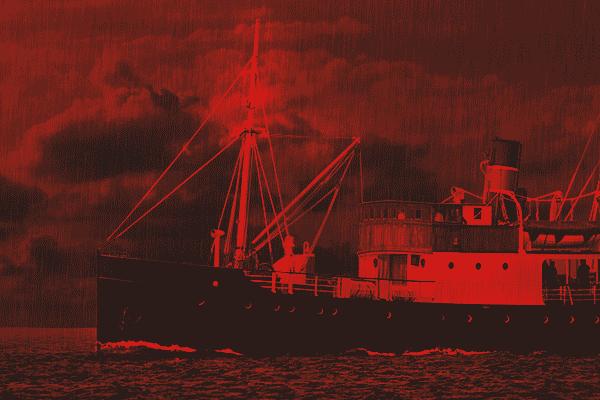| Boreal Herald Tribune | |
| February 1928 | Five Cents |
The Call of Cthulhu |
|
| By Howard Phillips Lovecraft | |
| Found Among the Papers of the Late Francis Wayland Thurston, of Boston | |
Of such great powers or beings there may be conceivably a survival... a survival of a hugely remote period when... consciousness was manifested, perhaps, in shapes and forms long since withdrawn before the tide of advancing humanity... forms of which poetry and legend alone have caught a flying memory and called them gods, monsters, mythical beings of all sorts and kinds...
The Madness from the Sea — Part 1
If heaven ever wishes to grant me a boon, it will be a total effacing of the results of a mere chance which fixed my eye on a certain stray piece of shelf-paper. It was nothing on which I would naturally have stumbled in the course of my daily round, for it was an old number of an Australian journal, the Sydney Bulletin for April 18, 1925. It had escaped even the cutting bureau which had at the time of its issuance been avidly collecting material for my uncle's research.
I had largely given over my inquiries into what Professor Angell called the "Cthulhu Cult", and was visiting a learned friend in Paterson, New Jersey; the curator of a local museum and a mineralogist of note. Examining one day the reserve specimens roughly set on the storage shelves in a rear room of the museum, my eye was caught by an odd picture in one of the old papers spread beneath the stones. It was the Sydney Bulletin I have mentioned, for my friend has wide affiliations in all conceivable foreign parts; and the picture was a half-tone cut of a hideous stone image almost identical with that which Legrasse had found in the swamp.
Eagerly clearing the sheet of its precious contents, I scanned the item in detail; and was disappointed to find it of only moderate length. What it suggested, however, was of portentous significance to my flagging quest; and I carefully tore it out for immediate action. It read as follows:
Mystery derelict found at sea
Vigilant Arrives With Helpless Armed New Zealand Yacht in Tow. One Survivor and Dead Man Found Aboard. Tale of Desperate Battle and Deaths at Sea. Rescued Seaman Refuses Particulars of Strange Experience. Odd Idol Found in His Possession. Inquiry to Follow.

The Morrison Co.'s freighter Vigilant, bound from Valparaiso, arrived this morning at its wharf in Darling Harbour, having in tow the battled and disabled but heavily armed steam yacht Alert of Dunedin, N. Z., which was sighted April 12th in S. Latitude 34° 21', W. Longitude 152° 17' with one living and one dead man aboard.
The Vigilant left Valparaiso March 25th, and on April 2nd was driven considerably south of her course by exceptionally heavy storms and monster waves. On April 12th the derelict was sighted; and though apparently deserted, was found upon boarding to contain one survivor in a half-delirious condition and one man who had evidently been dead for more than a week.
The living man was clutching a horrible stone idol of unknown origin, about a foot in height, regarding whose nature authorities at Sydney University, the Royal Society, and the Museum in College Street all profess complete bafflement, and which the survivor says he found in the cabin of the yacht, in a small carved shrine of common pattern.
This man, after recovering his senses, told an exceedingly strange story of piracy and slaughter. He is Gustaf Johansen, a Norwegian of some intelligence, and had been second mate of the two-masted schooner Emma of Auckland, which sailed for Callao February 20th with a complement of eleven men. The Emma, he says, was delayed and thrown widely south of her course by the great storm of March 1st, and on March 22nd, in S. Latitude 49° 51', W. Longitude 128° 34', encountered the Alert, manned by a queer and evil-looking crew of Kanakas and half-castes.
Being ordered peremptorily to turn back, Capt. Collins refused; whereupon the strange crew began to fire savagely and without warning upon the schooner with a peculiarly heavy battery of brass cannon forming part of the yacht's equipment. The Emma's men shewed fight, says the survivor, and though the schooner began to sink from shots beneath the waterline they managed to heave alongside their enemy and board her, grappling with the savage crew on the yacht's deck, and being forced to kill them all, the number being slightly superior, because of their particularly abhorrent and desperate though rather clumsy mode of fighting.
Three of the Emma's men, including Capt. Collins and First Mate Green, were killed; and the remaining eight under Second Mate Johansen proceeded to navigate the captured yacht, going ahead in their original direction to see if any reason for their ordering back had existed. The next day, it appears, they raised and landed on a small island, although none is known to exist in that part of the ocean; and six of the men somehow died ashore, though Johansen is queerly reticent about this part of his story, and speaks only of their falling into a rock chasm.

Later, it seems, he and one companion boarded the yacht and tried to manage her, but were beaten about by the storm of April 2nd. From that time till his rescue on the 12th the man remembers little, and he does not even recall when William Briden, his companion, died. Briden's death reveals no apparent cause, and was probably due to excitement or exposure. Cable advices from Dunedin report that the Alert was well known there as an island trader, and bore an evil reputation along the waterfront.
It was owned by a curious group of half-castes whose frequent meetings and night trips to the woods attracted no little curiosity; and it had set sail in great haste just after the storm and earth tremors of March 1st. Our Auckland correspondent gives the Emma and her crew an excellent reputation, and Johansen is described as a sober and worthy man. The admiralty will institute an inquiry on the whole matter beginning tomorrow, at which every effort will be made to induce Johansen to speak more freely than he has done hitherto.